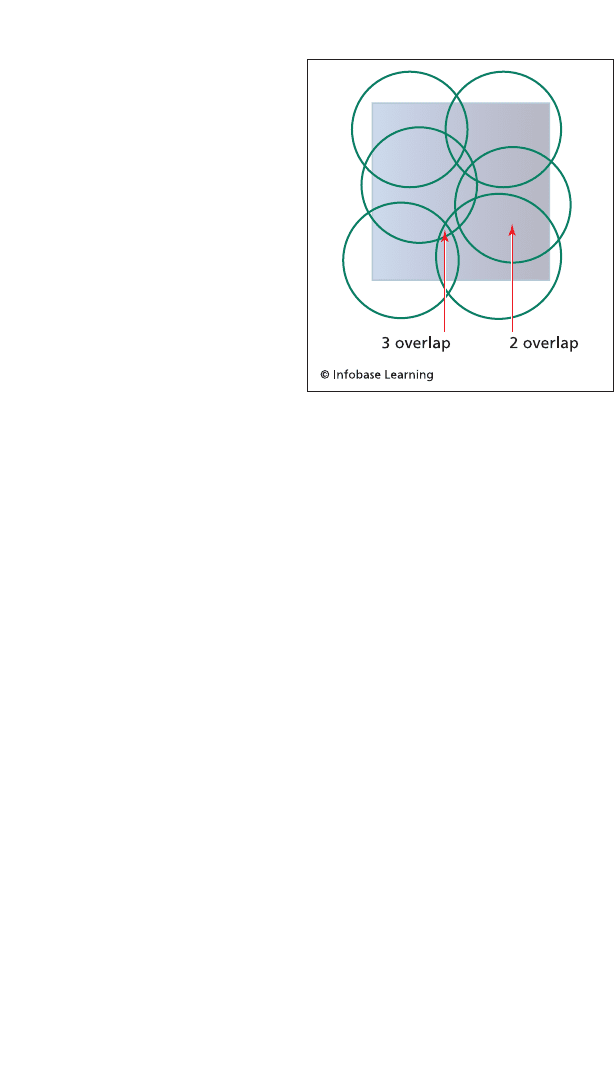Tabak J. Beyond Geometry: A New Mathematics of Space and Form
Подождите немного. Документ загружается.


130 BEYOND GEOMETRY
The Menger-Urysohn definition, which is called the small
inductive dimension and written ind(X), applies to regular spaces.
(Regular spaces were first described in chapter 5, page 91.) As
with the Brouwer-C
ˇ
ech large inductive dimension, ind(X) makes
use of the boundary of an open set to define dimension. Here is
the definition for the small inductive dimension of a topological
space X:
1. The empty set has dimension −1. In symbols, ind(∅) =
−1.
2. ind(X) ≤ n if for every point x in X and for every open
set V containing x, there is an open set U containing
x such that V contains both U and its boundary and
ind(boundary of U) ≤ n−1.
3. ind(X) = n if ind(X) ≤ n and it is false that ind(X) ≤ n − 1.
4. If condition 2 is not satisfied for any natural number,
then ind(X) is said to be infinite—that is, ind(X) = ∞.
Today, the definition ind(X) is more commonly used than Ind(X).
Here are some examples:
Example 7.1. Let X be a finite collection of points in the plane.
Draw a circle about each point with the property that all other
points in the collection are outside the circle. Then the bound-
ary does not contain any points of X—or, to put it another way,
the boundary is the empty set. By condition 1, the boundary
has small inductive dimension −1, and so the dimension at each
point of X is zero. We conclude ind(X) = 0.
Example 7.2. Let X be the topological space consisting of the
rational numbers. Open sets in X are the intersection of open
sets on the real line with the points of X. This space has ind(X)
= 0. To see that this is true, let x be any rational number, and
let V be any open set containing x. Let U be an open interval
centered at x and contained in V and such that U = {t: x − r < t <

Dimension Theory 131
x + r}, where r is an irrational number. Both x − r and x + r are
irrational numbers, so the boundary of U does intersect X, the
set of rational numbers. That means that in the space of rational
numbers, the boundary of U is the empty set. As a matter of
definition, ind(∅) = −1, and so we conclude that the dimension
of X is zero. (A similar argument shows that the dimension of
the topological space consisting of irrational numbers has small
inductive dimension zero.)
Example 7.3. Let X represent the circle of radius 1. The topol-
ogy of the circle consists of all possible unions of open arcs in
the circle and all finite intersections of open arcs. (An open arc
is an arc that does not contain its endpoints. We have used the
open arcs as a basis for the topology on X. See chapter 5, page
96, for a description of the idea of a basis.) Let x be any point in
X and let V be any open set containing x. Let U be an open arc
containing x and lying inside V, and choose U to be small enough
that its boundary also belongs to V. (The boundary of U con-
sists of two points, the endpoints of the arc.) As demonstrated
in Example 7.1, isolated points have dimension zero. Because
ind(boundary of U) = 0, it follows that ind(X) = 1. The circle is
one-dimensional.
Example 7.4. Let X represent the plane. Let x be any point in
the plane and let V be an open set containing x. Draw a small
circle around x so that the circle and its contents are inside V.
Let U be the interior of the circle so that the boundary of U is
the circle. By Example 7.3, ind(boundary of U) = 1. Therefore,
ind(X) = 2. The plane is two-dimensional.
What is important from the point of view of this history is that
mathematicians had to create definitions of dimension. They had
to give mathematical meaning to the concept. While the idea of
dimension may seem “natural,” a precise statement of this natural-
sounding concept is neither easy nor natural, and a useful definition
must conform to certain criteria. It must enable the user to compute
the dimension of those spaces that are already known—for example,

132 BEYOND GEOMETRY
the dimension of the real line should be 1—or at the very least,
if the computation produces results different from those that are
generally agreed to be correct, there must be a compelling reason
to accept the new results. Both Ind(X) and ind(X), for example,
yield reasonable and identical results for common spaces: For both
Ind(X) and ind(X), the real line is one-dimensional, the plane is two-
dimensional, and as we work our way up into the simpler higher-
dimensional spaces, the two functions continue to produce results
that (to a mathematician, at least) remain reasonable. Consequently,
both Ind(X) and ind(X) agree with our intuition when our intuition
is useful, and they produce good results for many spaces that have
no readily apparent geometric interpretation.
Of course, none of this explains why ind(X) (or any other defi-
nition of the concept of dimension) is important. Why do these
definitions matter? One answer is now easy to appreciate: The
number ind(X) is preserved under topological transformations. If
a space is n-dimensional according to the small inductive dimen-
sion, its dimensionality will be preserved by all homeomor-
phisms. Cantor, for example, wanted to show that n-dimensional
Euclidean space, which is represented by the symbol E
n
, and
m-dimensional Euclidean space (E
m
) are fundamentally differ-
ent, but he was unable to do so. In modern topological language,
he wanted to show that whenever m is not equal to n, E
n
and E
m
are not homeomorphic. If one concentrates on homeomorphisms
then (in order to show that E
n
and E
m
are not homeomorphic),
one must demonstrate the nonexistence of a homeomorphism
between the two spaces. When the problem is phrased in that
way, it is a hard problem to solve, but with a good definition of
dimension the proof is easy. Because ind(E
n
) = n, any space that
is homeomorphic to E
n
must also have dimension n. Because
ind(E
m
) = m, E
m
cannot be homeomorphic to E
n
unless m and n
represent the same number. This kind of “dimensional think-
ing” also disposes of the problems posed by Peano’s space-filling
curve: Because the small inductive dimension of the unit interval
is 1 and the small inductive dimension of the unit square is two,
the unit square and the unit interval are topologically different.
Consequently, Peano’s function cannot be “adjusted” to make it a

Dimension Theory 133
homeomorphism between the two sets. Similar statements apply
to the large inductive dimension.
A Noninductive Definition of Dimension and
More Consequences of Dimension Theory
A very different definition of dimension that was developed at
about the same time as ind(X) and Ind(X) is called the C
ˇ
ech-
Lebesgue definition of dimension. It was devised by the French
mathematician Henri-Léon Lebesgue (1875–1941), one of the
most influential mathematicians of the 20th century. Lebesgue
began his higher education at a college for teachers. After he
graduated, he studied mathematics by himself for about two years.
As he studied the work of some of the best mathematicians of his
time, Lebesgue realized that he could make a contribution to the
field of analysis that was uniquely his. Today, his major contribu-
tion is known as the Lebesgue integral, and it is recognized as one
of the great achievements of 20th-century mathematics.
As the 19th century drew to a close, mathematicians were strug-
gling to solve problems using techniques that required that the
functions under study be continuous, or at least continuous except
at a few isolated points. Lebesgue found a way to extend the tech-
niques then in use. His extension agreed with the old techniques
when the old techniques were applicable, but it applied in many
cases in which the old techniques were inadequate. Lebesgue’s
work in analysis remains an important part of the education of
every serious student of mathematics today.
Lebesgue remained active in mathematics throughout his life,
and he did not hesitate to attempt to solve difficult problems in
branches of mathematics other than analysis. In particular, he
worked in topology, and his contribution to dimension theory
is remarkable because it is highly original and very simple. It
depends on the notion of an open cover. (Open covers were dis-
cussed in chapter 5, pages 85–86. The definition is briefly repeated
here because it is used in a very different way.) Let X be a normal
topological space, and let {U, V, W, . . .} be a collection of open
subsets of X. If every point in X belongs to at least one of the sets

134 BEYOND GEOMETRY
in {U, V, W, . . .}, then the set {U, V, W, . . .} is called an open cover
of X. There are usually many different open covers of any topo-
logical space X, and it is usually possible to “refine” every such
cover in the following way: Replace {U, V, W, . . .} by the open
cover {U′, V′, W′, . . .} where U′ is a proper subset of U, V′ is a
proper subset of V, and so forth. The set {U′, V′, W′, . . .} is called
a refinement of {U, V, W, . . .}.
The order of a cover is the largest number of sets to cover a
single point. So, for example, if for a particular cover at least one
point belongs to two sets and no point belongs to three sets, then
the order of the cover is 2. Here is Lebesgue’s definition: If for
every open cover of a topological space X there is a refinement
with order not greater than n+1, and n is the smallest integer for
which this statement is true, then X has C
ˇ
ech-Lebesgue dimen-
sion n. (The C
ˇ
ech-Lebesgue dimension of a topological space is
written dim(X).)
Example 7.5. Consider the topological space {x: 0 < x < 1}. Every
open cover of this space that consists of at least two sets has a
refinement of order 2. Here, by way of example, is an open cover
of {x: 0 < x < 1}: Let U = {x: 0 < x <
2
⁄
3
}, and let V = {x:
1
⁄
3
< x < 1}.
The point
1
⁄
2
, for example, belongs to both sets. We can refine
U and V in many different ways, but it is impossible to entirely
eliminate the overlap and still cover the space. This illustrates
the fact that {x: 0 < x < 1} has C
ˇ
ech-Lebesgue dimension of 1.
Lebesgue actually stated his theorem only for cubes in E
n
. It was
generalized to a broader class of topological spaces and made more
precise by C
ˇ
ech many years later.
Mathematics is often presented with an air of finality—as if the
subject appeared in its final state and no alternatives are possible.
But in these three definitions of dimension, one can see some of
the most astute mathematicians of the 20th century struggling to
create a concept that is mathematically rigorous and yet does not
defy “common sense” notions of what the word dimension means.
These mathematicians arrived at three distinct solutions to this
problem, and they are distinct, not just in form but in concept.

Dimension Theory 135
While they all yield the same
dimension for the most com-
mon spaces, they give different
results when they are applied
to less common spaces.
It is tempting to ask which
definition is correct, but that
assumes that there is a correct
definition. There is no single
correct definition. Each defi-
nition has, however, proved
to be useful in the sense that
it has helped mathematicians
better understand the math-
ematical “universe” they have
created. Cantor’s discovery of
one-to-one correspondenc-
es between sets of different
dimensions and Peano’s space-filling curve had caused mathemati-
cians to question whether the concept of dimension had any real
meaning. The work of Brouwer, Urysohn, Lebesgue, Menger, and
C
ˇ
ech resolved those concerns. They showed that dimension, no
matter which definition is used, has a reasonable interpretation
and is preserved under topological transformations. Once the con-
cept of dimension was rigorously defined, Urysohn showed that
the question that had plagued Cantor, the relationship between
the cardinality of a set and the dimension of a set, turned out to
have an easy answer. Urysohn discovered that the points of any
topological space of positive dimension can be placed in one-to-
one correspondence with the set of real numbers.
Dimension theory seemed to be a “mature” subject by 1950.
The pace of discovery had waned, and while there were still
unanswered questions—because there are always some unan-
swered questions—it did not appear that there was much of
importance that remained to be discovered. This was the conclu-
sion of Witold Hurewicz and Henry Wallman, the authors of the
1941 volume Dimension Theory, a book that remains an important
While this open cover of the square
can be further refined, all additional
refinements will leave some points
of the square simultaneously inside
three discs.

136 BEYOND GEOMETRY
contribution to the field. They were wrong. Dimension theory
was revived in the 1950s, in large measure due to the work of the
Japanese school of topologists (see chapter 6). Kiiti Morita proved
a number of important theorems in this regard. He extended the
classical concept of dimension to new types of spaces. He found
new and simpler ways to estimate the dimensions of various
spaces, and he discovered some very important facts about the
nature of infinite-dimensional spaces. Unfortunately, the discov-
eries of the Japanese school are quite technical, too technical to
summarize here. Because they began their inquiries where the
previous generation of topologist left off, their simplest results
are often extensions of a highly evolved theory, but the theorems
discovered by the Japanese school reinvigorated the subject and
demonstrated that there was still a great deal to learn about
the concept of dimension. Dimension theory remains an active
branch of mathematics today.
Still Another Concept of Dimension:
The Hausdorff Dimension
Felix Hausdorff investigated a definition of dimension different
from the three definitions considered already, and as any good def-
inition of dimension should, Hausdorff’s definition agrees with the
other definitions for the usual simple cases, such as the real line,
the plane, and so forth. What distinguishes Hausdorff’s concept of
dimension is that it need not be a natural number. The Hausdorff
dimension of a set can be understood as an attempt to character-
ize the dimensionality of a particular kind of set. They once were
called pathological sets; now they are called fractals. The person
most responsible for popularizing these sets is the Polish math-
ematician Benoit Mandelbrot (1924–2010). The following briefly
examines the nature of these sets in order to develop an apprecia-
tion for why it can be worthwhile to assign such sets a fractional
dimension.
In describing what a fractal is, Mandelbrot famously used the
example of measuring the coast of Britain, and his example is
worth repeating. From low Earth orbit, for example, the coast of

Dimension Theory 137
Britain does not look straight. It consists of sections of coastline
that are relatively straight connected by sharp changes in direc-
tion. We could, therefore, approximate the length of the coast by
measuring the lengths of the straight sections and adding them
together.
Now suppose that we fly along one of these apparently “straight”
sections of coast in an airplane at an altitude of a few miles. At this
Part of the coast of Britain (and all of the coast of Ireland) as seen from
orbit. Because the coastline has the property of self-similarity, the measured
length of the coastline depends on the length of the ruler one uses to
measure it.
(NASA)

138 BEYOND GEOMETRY
lower altitude, what looked like a straight section from orbit will
not look straight at all. In fact, each section will look very similar
to the entire coast as we saw it from orbit. The segments that
from orbit appeared to be straight will, from the airplane, appear
to consist of many short, straight segments interrupted by sharp
changes in direction. The section that we see from the airplane
will not, of course, be identical with a section of coast as viewed
from orbit, but it will be similar. In fact, if we are shown traces of
segments of coastline as viewed from orbit and traces of segments
of coastline as viewed from the plane—traces so as to prevent us
from identifying the height of the observer from the context of the
picture—then we would be unable to distinguish the orbital view
from the aerial view. Moreover, if we measure each of these short
(aerial) segments and add the segments together, the length of a
stretch of coastline when viewed from the plane will be much lon-
ger than the length of the same stretch of coastline when viewed
from space.
Now isolate a segment of the coast that looked straight when
viewed from the airplane. Suppose we walk along that segment
and look closely at the boundary that separates land from sea.
We would see that the boundary that separates land from sea has
the same general shape as the boundary that we saw from space,
which is also the shape that we saw from the plane. From our
position along the water’s edge, the boundary between the land
and sea will appear to consist of short straight sections connected
by sharp angles, but these straight sections are much shorter than
the ones we saw from the plane. If we measure these straight-
looking segments and add them together, we obtain a much lon-
ger estimate of the coast of Britain than we obtained from viewing
it from the plane, which was much longer than it appeared when
viewed from space.
Now imagine viewing the line that separates the land from
the sea with a magnifying glass. We would see a series of short
straight-looking segments joined by sharp curves, the very same
properties that we saw when we looked at the coast from orbit.
This is a physical approximation of a mathematical property called
self-similarity. Each segment of the coast, whether viewed through

Dimension Theory 139
a magnifying glass or from outer space, exhibits the same jagged
property, and the length of the coast depends on how close we are
when we measure it.
Mandelbrot did not discover the property of self-similarity. It
was well known to early topologists. The Sierpi´nski gasket—see
page 76—is self-similar; it is invariant under changes of scale.
No matter how small a piece of the gasket that we magnify and
examine, we see essentially the same thing: a mesh with triangular
holes of varying sizes oriented according to the same pattern, and
the Sierpi´nski gasket demonstrates another important property
of fractals: They are usually generated by following very simple
rules. The procedure for creating many common fractals begins
with a straight line segment. The segment is symmetrically bro-
ken into a collection of segments, and then the rule is applied to
each of the individual segments. The result is a larger collection
of shorter segments. The procedure is repeated again and again.
A simple procedure repeated indefinitely is what causes the figure
to be self-similar.
This property of self-similarity stands in sharp contrast to the
sort of curves that were studied by earlier generations of math-
ematicians. They studied curves that are differentiable, and dif-
ferentiable curves are generally not self-similar. No matter how
the curve seems to twist and turn when viewed from afar, at high
enough magnification every differentiable curve will be indistin-
guishable from a straight line. In fact, unless a curve is almost
straight over a short enough distance, it will not have a derivative.
By contrast, fractals generally fail to have derivatives anywhere
because even over very short distances they are never approxi-
mately straight.
As has been mentioned at various places in this narrative, topol-
ogy, because it is so general, allows for a great many sets with
unexpected properties, and part of learning topology involves
expanding one’s notions about what is possible. Hausdorff’s dimen-
sion, in particular, can be understood as an attempt to characterize
the in-between-dimensions property that many fractallike sets
have. The mathematics of computing the Hausdorff dimension
of a set is beyond the scope of this history, but with respect to the
